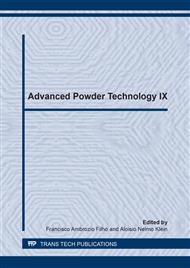p.457
p.462
p.467
p.472
p.477
p.483
p.491
p.496
p.501
Effects of Hydrogen Content in Nitrogen-Based Sintering Atmosphere on Microstructure and Mechanical Properties of Fe-0.3%C-0.1%B Alloy
Abstract:
For the sintered materials, the mechanical properties are strongly dependent on the density of the final product. A substantial reduction of the porosity can be achieved using additives in the powder mixture which promote the formation of a liquid phase during sintering. Boron is a potential liquid phase promoter in ferrous alloys, when sintering is carried out using hydrogen or argon atmospheres. These atmospheres, however, are costly, and the use of nitrogen containing low content of hydrogen could be beneficial. In this study the effects of 10 to 50% hydrogen in nitrogen atmosphere on the microstructure and mechanical properties of a Fe-0.3%C-0.1%B alloy sintered at 1120 and 1250°C were investigated. Boron addition increased the sintered densities, but lowered the transverse rupture strength and hardness in relation to the control alloy (Fe-0.3%C). No significant differences were observed among the samples sintered in different atmospheres for each alloy. Nitrogen containing up to 50% hydrogen atmosphere is not suitable to sinter Fe-C alloy containing boron since it lowers the mechanical properties with the formation of fragile boron nitride precipitates at the grain boundaries and lower perlite fraction.
Info:
Periodical:
Pages:
477-482
Citation:
Online since:
December 2014
Keywords:
Price:
Сopyright:
© 2014 Trans Tech Publications Ltd. All Rights Reserved
Share:
Citation:


